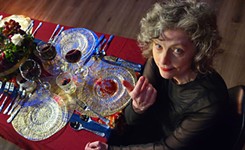Visual Arts Review: Karim B. Hamid’s “Saturn Returns”
Lydia Street exhibit ponders subversion and deconstruction
By Cat McCarrey, Fri., Jan. 3, 2025
It’s impossible not to have a visceral reaction to the grotesque images headlining “Saturn Returns.” In most of the works in his Lydia Street Gallery exhibit, Karim B. Hamid paints nude women in an exaggerated, breast-forward manner, their faces smeared and blurry, and makes collages out of vintage pornography. At first glance, it’s repulsive.
I chatted with Hamid the day before Lydia Street’s Dec. 14 “Saturn Returns” reception, when he had just driven from Miami after showcasing some of his work at Art Basel. Once the artist told me he ranks Francis Bacon, as well as classicists like Caravaggio, among his heroes, my reaction to his work made more sense. I respond to Bacon’s bloodied canvases with the same intensely primal rejection – though such works can be rewarding with close reexamination.
It’s a process Hamid calls “psychic archaeology,” the act of allowing your brain to sink into the layers of a work. These layers prove to be both metaphorical and literal, as he leaves obvious signs of creative destruction in each piece. Remnants of tape and the ghosts of different faces, tested and rejected behind figures, signal the trials behind every finished product. This experimentation is central to one’s Saturn return, or the time at which the planet returns to the same place it was at the time of a person’s birth. The astrological transit occurs every 27-30 years in a person’s lifetime and often inspires periods of self-discovery and growth; Hamid is in the midst of his second Saturn return right now.
Hamid also told me about the restriction of his formal art training, which inspired him to subvert the classics. Mixing the sacred and the profane, “Saturn Returns” combines high art tropes – Victorian ladies and Southern gentlemen are the subjects of the artist’s other pieces, not just nude women – with “low” forms, like advertisements and pornography.
This mindset completely changes the viewing experience. Collages like Forced Labor (Reversed Twice) no longer just depict faceless forms performing sexual acts. New details, like the dramatic fold of the curtains and the precise angle of the bed, pop from the frame. Curtains reappear in many works, like fa.fn60/Viaticum, where a praying angel hovers over the quad-boobed form of a woman whose visage has been wiped and re-created many times. The woman’s solemnly gorgeous face holds echoes of any Christian Madonna, but is overshadowed by the brash nudity central to the painting. While her final expression stands in stunning profile, ghosts of different head positions haunt the bed frame behind her, lending to the archaeological excavation of the work.
Once the classical inspiration is clear, the art becomes a scavenger hunt. It’s suddenly easier to see how Hamid’s use of floating cherubs and sacred positioning could be informed by Raphael and Rembrandt, and his use of purposeful destruction, plaster painting, duct tape, and visible sketchwork becomes another way to unearth insight, especially into what each viewer notices.
Hamid juxtaposes these vulgar historical nods with the peaceful sweetness of “Melancholia,” a series of old photos overlaid with preserved butterflies and moths showcased within the same exhibit. During our conversation, he told me he was an avid traveler and estate sale shopper with a particular affinity for old daguerrotypes. In working with the vintage portraits, he asks himself, “How can I bring these people back around?” Here, he’s taken those once-precious photographs and honored their subjects while preserving anonymity, placing a winged insect over their faces. Where Hamid’s other work could be seen as lurid, the pieces in “Melancholia” have no preconceived notions to wrestle with before appreciating the work. They’re immediately lovely.
In jazz music, musicians have to know musical theory so well that it becomes a tool in their arsenal. In other words – they have to know the rules to break the rules. Karim B. Hamid knows the rules of high art, and he sure enjoys breaking them. While the results run the gamut in terms of gut response, they can’t be denied.
Karim B. Hamid: “Saturn Returns”
Lydia Street Gallery
Through January 10 by appointment
January 11-26, 12-5pm weekends; weekdays by appointment











